You can measure employee productivity by:
- Using productivity formulas
- Monitoring the number of tasks completed
- Tracking working and overtime hours
- Using surveys
- Tracking time spent on tasks
- Setting up recurring catch-ups and updates
We will analyze each of these ways in detail in this article.
Also, we will explore critical tips and challenges of measuring employee productivity and how to set productivity goals for your employees.
Why is it important to measure employee productivity?
Measuring employee productivity is crucial and has benefits for both employers and employees. There are a few key reasons why you should be measuring it:
It benefits the employees
Measuring your employees’ productivity can highlight their strengths and growth areas. This strategy boosts their career path, morale, and job satisfaction.
Also, it gives them a clear overview of their work performance so they can focus on improving their skills, use their time efficiently, and achieve a better work-life balance.
It helps the company grow
Tracking your team’s productivity enables you to make intelligent hiring decisions, optimize work processes, and grow your business.
It helps to measure company performance
Assessing overall productivity also enables you to get a clear picture of your company’s health.
See if your team’s size, skills, and performance align with your business goals and ensure your company stays on its growth path.
What are the methods of measuring productivity?
There are three standard methods of measuring employee productivity. Let’s dive into each of them.
Quantitative methods
Quantitative methods are about numbers.
For example, you can look at the number of tasks completed in a workday. Or a lagging metric such as revenue per employee.
Quantitative metrics provide precise data and are great for quick checks on how things are going. But you miss out on qualitative details like work quality, employee workloads, and work difficulty.
So, it’s wise to use these metrics along with other methods that look at the qualitative aspects. That way, you ensure employees are busy and do quality work that helps the whole business.
Objective-based methods
Objective-based methods gauge work performance by comparing outcomes to predefined SMART goals—specific, measurable, achievable, relevant, and time-bound.
Collaboration becomes seamless when everyone shares the same goal, and the focus shifts from merely completing tasks to hitting collectively agreed-upon targets.
This method ensures that individuals are not aimlessly occupied with tasks that do not drive the business forward. Achieving these objectives not only boosts motivation but also enhances productivity.
Task-based methods
In task-based methods, you analyze the individual tasks within your employees’ roles.
You break down each job into parts, assess their time and resource consumption, and identify areas for potential improvement through training.
While thorough, this approach requires time and a good understanding of the team’s workflow.
What are some actionable ways to measure employee productivity?
Let’s see how these seven actionable ways can help you measure employee engagement and productivity.
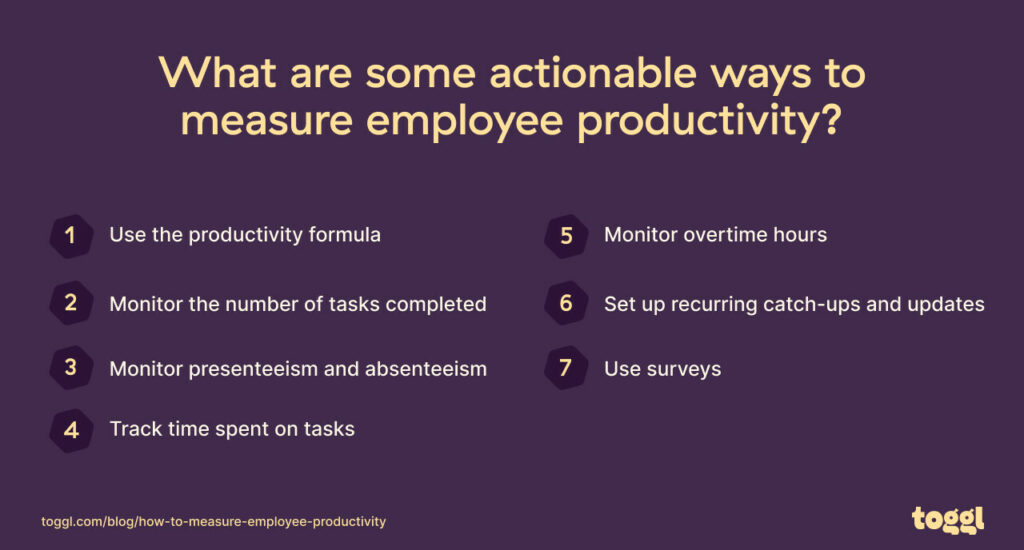
1. Use the productivity formula
The productivity formula calculates individual or company efficiency by comparing the output(projects, tasks, revenue) to the input resources.
Productivity = Delivered output / Input resources
This straightforward formula gives you a quick, quantifiable measure of your team’s performance and productivity.
For example, let’s say you run a content writing agency. A writer delivers 2×2000 word articles in a week. For a 40-hour work week, the writer’s productivity is calculated as:
Productivity = 4000 words / 40 hours = 100 words/hour2. Monitor the number of tasks completed
Tracking how many tasks employees complete weekly or monthly gives you a precise productivity rate. It’s a quick way to see your project team’s progress in a set time.
Tracking completed tasks with a project management tool like Toggl Plan is easy.
The Project Progress Overview feature in Toggl Plan outlines the progress of your entire project in one view.
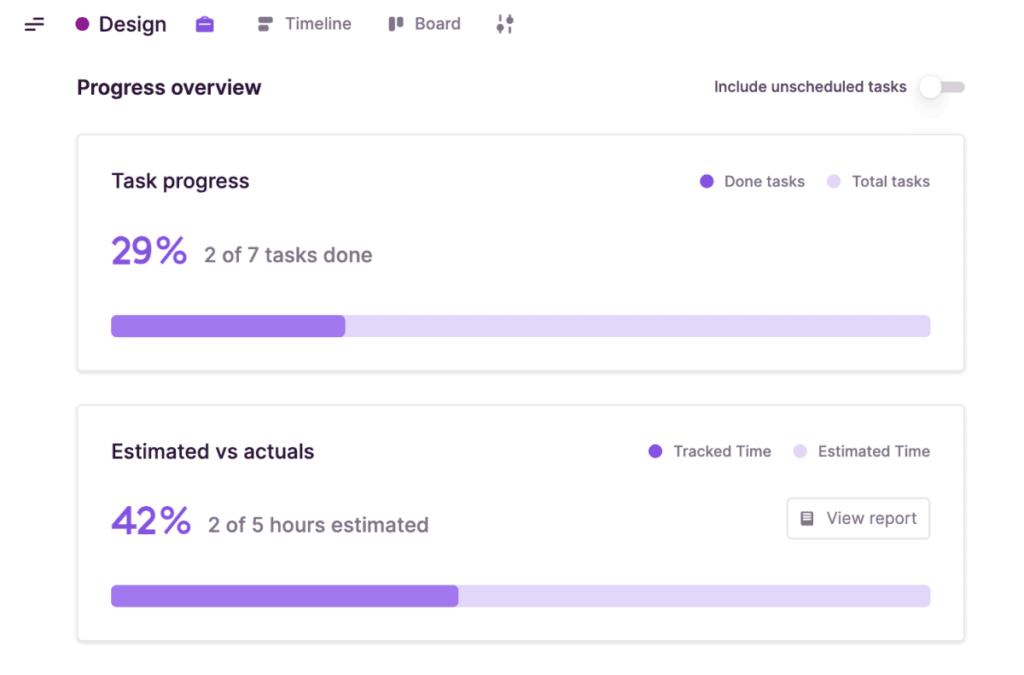
Easily track task progress and compare actual tracked time against your estimated time.
Also, you can use the Board view in Toggl Plan, to easily drag and drop tasks into columns.
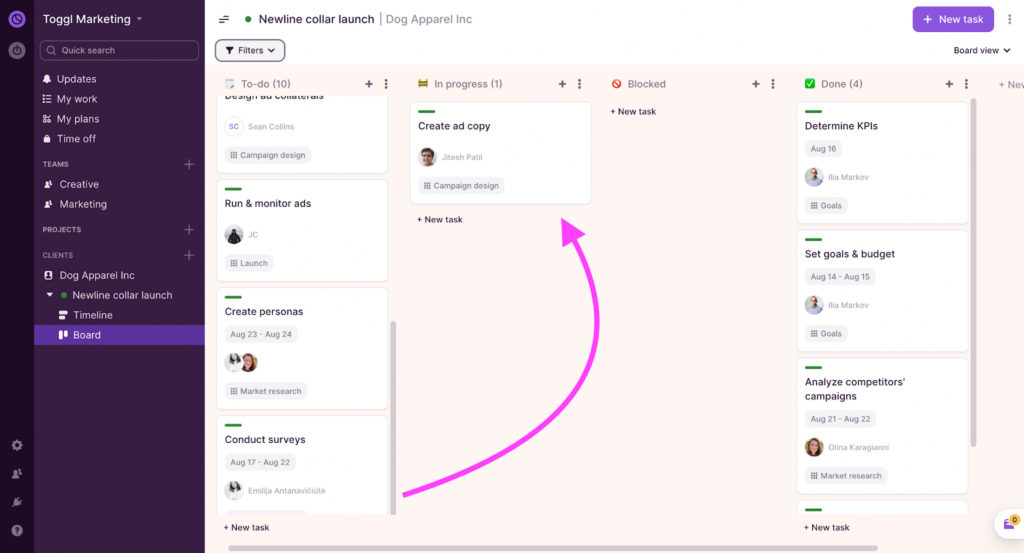
Quickly visualize tasks that are in progress or haven’t started, or get a clear overview of completed tasks.
3. Monitor presenteeism and absenteeism
Absenteeism means taking time off beyond the company policy without a viable reason. It impacts workflows and puts pressure on other team members who cover for absent co-workers.
Presenteeism might be less obvious, but it is equally harmful.
It happens when employees come to work but are not fully productive due to illness or personal issues. They’re physically present but mentally distracted, resulting in mistakes and low-quality work.
Both absenteeism and presenteeism can spread the team too thin. Other team members may need to compensate for the lack of productivity, causing imbalanced workloads, increased stress, and eventually burnout.
To avoid this, identify and address the root causes of these behaviors early.
With Toggl Plan’s Time Off feature, you can easily keep track of your team’s time off.
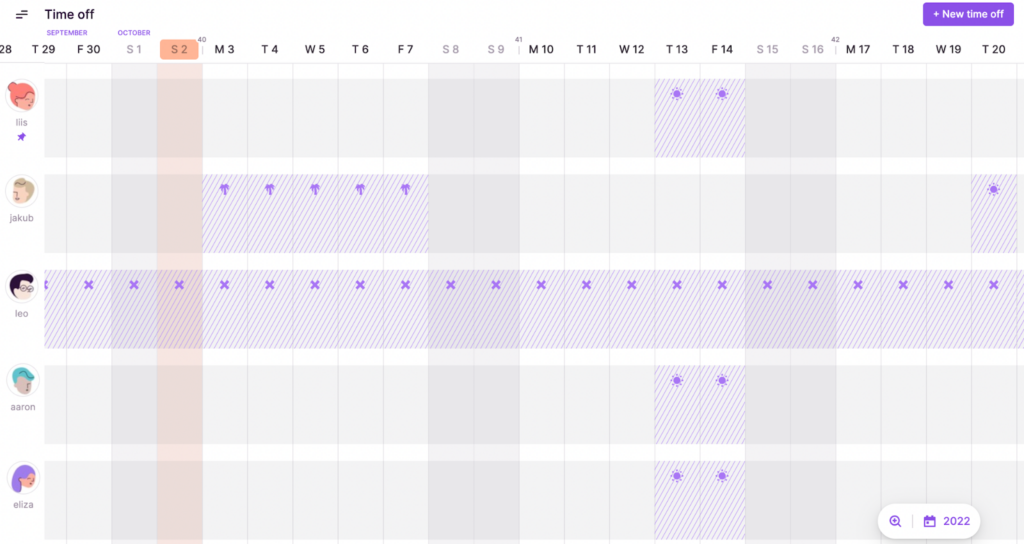
The Time off view provides a quick overview of your team’s time away from work and lets you spot any issues early on.
Also, you can use the Team timeline view to spot who’s working too much or not enough and rebalance workloads.
4. Track time spent on tasks
Keeping track of how your team spends time on tasks also helps you measure and improve productivity.
Using time reports, you can know how much time a task takes, identify patterns, understand work rhythms, and make data-driven changes to make your team’s workflow efficient.
But how do you get your team to track time?
First, avoid monitoring and micromanaging your team members. Second, give them a tool that makes it easy to track time. And finally, use the time reports to improve your team’s productivity by weeding out inefficiencies.
Toggl Track is a simple time-tracking tool that helps you with all three.
Its anti-surveillance stance means you don’t monitor your employees with screenshots or track their mouse movements and keyboard clicks.
Toggl Track also makes tracking time a breeze. You can add manual time entries or start and stop the timer to track time.

Finally, you get time reports that help you analyze team productivity and project profitability.
For example, the Summary report lets you visualize the time tracked for specific tasks.
To access the Summary report, click on the Reports tab on the left side of the screen and select Summary from the top center of the screen.
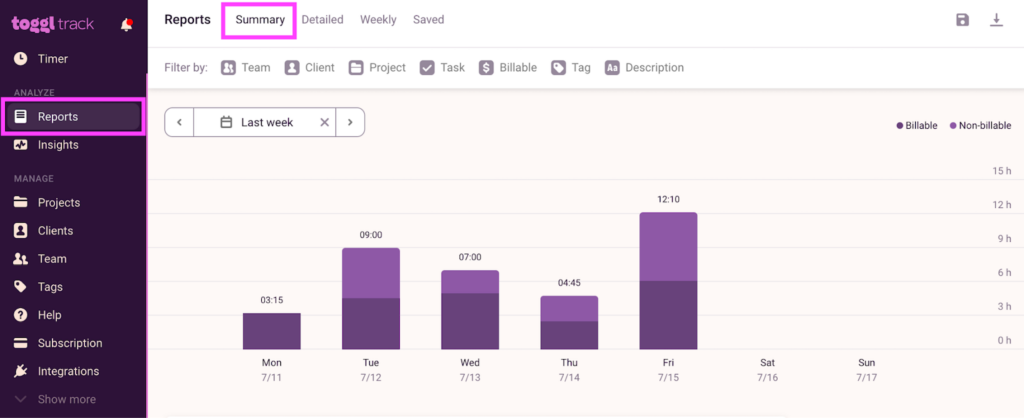
You can filter the data you want to see in your report by team, client, project, task, and more.
This data lets you easily measure your team’s productivity and spot any gaps.
The Detailed report shows an in-depth look at your tracked time so you can measure productivity even in more detail.

See each employee’s time entries and easily edit and export data into PDF, CSV, or Excel format.
5. Monitor overtime hours
If your team consistently works overtime hours, it’s a clear sign that something is off.
Have you set impossible deadlines? Is the project scope constantly changing? Is absenteeism or presenteeism a problem within your team?
Constant overtime hours lead to overwork, errors, and a decline in morale. You must track overtime to catch any negative patterns early. Use it as a prompt to reassess workloads and deadlines.
Addressing the root causes of constant overtime protects your team’s well-being and keeps productivity levels high.
6. Set up regular 1:1 meetings
Regular 1:1 meetings keep you stay in the loop with each team member’s progress and struggles.
Use these meetings to understand what’s stopping your team members from meeting their goals. It’s also your team’s time to share what’s working, what’s not, and what they think could change.
Monthly 1:1 check-ins help clear roadblocks, realign focus, and keep your team moving forward.
7. Use surveys
Team members may not be comfortable sharing feedback directly.
Anonymous team surveys can be a real productivity power-up as they allow your team to open up and provide you with a holistic view of your team’s concerns.
Internal surveys mean asking your employees how they feel about their work environment. Questions you can ask your employees sound like:
- What boosts your productivity?
- What slows you down?
- What could the company do differently to improve your productivity?
You can also use external surveys to measure productivity. You can ask your clients questions like:
- Are you happy with the work quality?
- Are you satisfied with the service speed or amount of work?
- Have you experienced any repetitive issues or delays in our services?
By surveying employees and clients, you get a 360-degree view of how your team works and where they could improve things.
Tips on measuring employee productivity
When measuring employee productivity, consider these four tips:
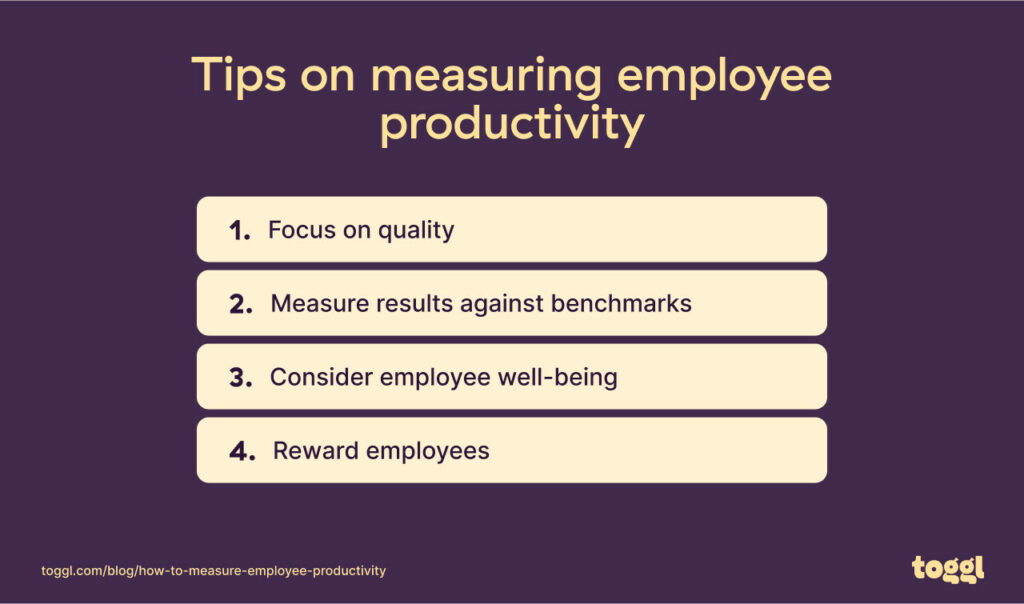
Let’s look closely at each.
1. Focus on quality
You can measure the quality of your team’s work by looking at:
- Subjective measures like customer feedback or peer reviews.
- Objective measures like industry-specific quality metrics.
You should set quality standards before measuring productivity to ensure your results are accurate and aligned with your standards.
2. Measure results against benchmarks
Set clear, achievable benchmarks. Then, measure your employee’s performance against these standards.
This method shows who exceeds expectations and who needs support. It’s not about pitting staff against each other. It’s about ensuring consistent, fair evaluations.
Compare current performance with past data. Is there improvement? Decline? Understand the ‘why’ behind the trends. Then, you can use these insights to train your employees and improve their productivity.
3. Consider employee well-being
Productivity and well-being go together because happy, healthy employees mean higher productivity.
On the other hand, overworked, stressed employees burnout and churn.
It pays to recognize the signs early. Are your employees taking more sick days? Are they voicing concerns?
Considering work-life balance in your productivity assessment is a must. And taking action to solve any issues here is equally important.
4. Reward employees
Incentives drive performance. Recognize your top performers and reward them.
Rewards don’t always mean bonuses. Public recognition, extra vacation days, or opportunities for professional growth are potent motivators.
Tailor rewards to what your employees value. This acknowledgment will make them feel valued and increase their motivation and performance.
Challenges in measuring employee productivity
There are three common challenges team leaders and managers face when measuring employee productivity.

We’ll discuss each of them below.
1. Measuring productivity for remote employees
Remote work complicates traditional tracking methods.
You lack direct oversight in physical offices, so assessing your employees’ engagement and actual labor hours is hard.
It’s tricky.
Using employee monitoring or surveillance software erodes trust. Rely only on measuring output; you may miss the context — like uneven workloads or collaboration issues.
How can you solve this challenge?
Communicate expectations, hold regular check-ins, and use productivity software and productivity tracker apps to track task progress transparently.
Toggl Track can help you do that easily by seamlessly keeping track of work hours.
With Toggl Plan, you can manage tasks and projects effortlessly and clearly overview your employee’s tasks.
2. Taking quality into account
Quality is as important as quantity when measuring employee productivity.
However, setting standard quality metrics is challenging due to varying industry standards, subjectivity, and diverse job roles.
To help measure the quality of your employees’ work, you can also consider:
- Customer feedback
- The impact of your employees’ work
- Peer reviews
You can also use industry benchmarks to measure quality, such as the number of support tickets closed weekly.
Once you decide on a metric, set quality standards before you measure productivity trends.
3. Too much data
You can track almost everything, but should you?
For example, Some time-tracking software takes periodic screenshots of an employee’s app. Sifting through all these screenshots to see if your employee is productive is overwhelming and counterproductive.
The challenge lies in identifying relevant but simple metrics that align with your business goals.
Set clear KPIs and use targeted time analytics tools to focus on relevant employee productivity data for your business.
How to set productivity goals for employees
Clear, achievable goals promote accountability and can improve your employees’ productivity.
Here’s how you can set productivity goals practically:
1. Establish KPIs
Key performance indicators (KPIs) show how effectively employees achieve key business objectives.
KPIs should be relevant to both — your business objectives and individual roles.
Clear KPIs keep your employees accountable and motivated.
2. Establish benchmarks
Benchmarks are reference points that create a performance threshold.
Establishing benchmarks can motivate your employees to meet or exceed expectations. But make sure these baselines are realistic and achievable.
3. Leverage the SMART framework
The SMART (Specific, Measurable, Attainable, Realistic, and Time-bound) framework helps you clarify goals and set deadlines.
SMART goals keep employees focused and help you track their progress. Also, setting SMART goals gives a transparent view of deliverables and boosts employee productivity.
4. Break down goals into smaller ones
This step-wise approach makes complex goals more approachable and less overwhelming.
Breaking down goals into smaller ones improves focus and provides quick wins, keeping motivation high.
In addition, it will make it easier for employees to follow their progress and stay on track.
5. Provide feedback
Lastly, provide regular, constructive feedback.
Why?
It helps employees understand their progress, feel valued, and improve their weaknesses.
Now over to you
You now know how you can track, measure, and improve your team’s productivity.
It takes the right data from the right tools.
Toggl Plan and Toggl Track can be your productivity allies and help you:
- Track time spent on tasks
- Generate relevant reports, identify productivity bottlenecks, and make a plan for improvement
- Keep track of progress and completed tasks
Sign up for a free Toggl Plan account.
Frequently Asked Questions (FAQs)
Still got questions? Below are some of the most common questions about employee productivity.
What factors can increase employee productivity?
These factors can increase productivity:
- Money and resources: Financially satisfied employees are generally more productive.
- Learning and training: Special job training helps employees acquire new skills, makes them more confident, and more productive.
- Experience: When employees do the jobs for a long time, they get better at it and are more productive.
- New technology: Using the newest tools and systems makes work faster and easier.
What factors can reduce employee productivity?
These factors can reduce employee productivity:
- Poor management: Ineffective leadership can lead to unclear expectations, low morale, and less productivity.
- Overwork: Excessive workloads or long hours can result in burnout and fatigue, decreasing overall productivity.
- Poor communication: Ineffective communication can lead to errors, repeated work, and wasted time.
- Lack of recognition: Not acknowledging or rewarding employees can decrease motivation and productivity.
What are some common KPIs for measuring employee productivity?
The most common KPIs for measuring employee productivity are:
- Absenteeism rate
- Projects completed
- Overtime hours
- Profit
- Customer satisfaction
- Downtime
- Number of tasks completed
- Number of hours spent on tasks
Looking for an app to track employee time but don’t know where to start? We’ve got a handy list of all the best employee time tracking apps to help you out! We tested each app and grouped them to fit every business need, whether you’re a small team or a large enterprise.
Work tools to elevate your productivity – apps for incredibly simple time tracking and effective project planning.